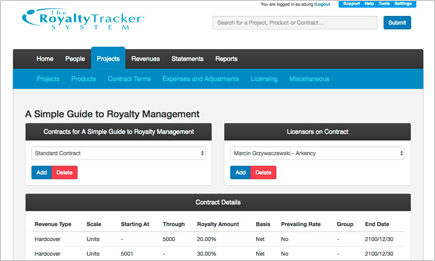No Results Found
The page you requested could not be found. Try refining your search, or use the navigation above to locate the post.
The page you requested could not be found. Try refining your search, or use the navigation above to locate the post.
Royalty Management is data manipulation: Recording your sales, converting those sales into royalties, applying any adjustments, then consolidating all that data onto a royalty statement. And the heart of royalty management data is the contract: The rules for how sales are converted into payments to authors.
The biggest challenge, and therefore the biggest risk, in any royalty system setup is migrating your contract data. Fortunately, MetaComet is the best in the business at helping you do this. Over the years, thanks in large part to our MetaGoLive® Process, we have developed a reputation for providing the fastest, smoothest data migrations, whether you are migrating from another system or manually entering your contracts. We will get you up and running fast, ensuring the quickest return on your investment, and the greatest peace of mind.
How do we do it? We take a simple yet cutting edge approach: Agile, iterative, test-based.


Whether migrating or entering data manually, most companies have a database of their titles, ISBNs, and authors. MetaGoLive makes this information easy to migrate. Simply provide an Excel spreadsheet or CSV file, and we’ll do the rest. When you next log in to Royalty Tracker, you’ll see all this information has automatically been populated.
From here, you will now have three options for migrating your contract details: manual, automated, or a combination of both.
If your current contracts are stored as data, for example you are switching to Royalty Tracker from another royalty system, then we can automate the migration. As part of MetaGoLive, we have a powerful contract migration tool. We will work together to convert your data into one of our migration formats, and MetaGoLive does the rest, providing you with a detailed log of any issues.
We take an agile, iterative approach. Don’t worry about getting it right the first try (or the second, or even the third, etc). We’ll show you all the issues, so you can adjust your data accordingly. And because of our simple yet powerful testing protocols (see below), it’s easy to make corrections and confirm that you did it right.
Need help preparing your data? We are experts! Some of our customers even email us a database that they don’t know what to do with, and rely on us to get it loaded into Royalty Tracker. We are happy to help.


Are you switching from a manual process? Or perhaps your current system does not provide a mechanism to export your contract data. In either case, you will need to at least in part enter your contract details manually. But don’t worry! It’s actually pretty easy:
As a rule of thumb, it takes 1 person about one week to manually enter 1,000 moderately complex contracts (we actually time people entering contracts to get this number). A couple of hundred contracts can be entered in a day. And as with everything, we test, test, test, so you’ll have confidence that your data entry was done correctly.
Data migrations fall on a spectrum. At one end is a fully automated data migration, with no manual intervention. At the other end is pure manual data entry, with nothing imported into Royalty Tracker. Most companies fall somewhere in between. There are many ways we can help:
No matter your data situation, we will work closely with you to assess the best solution for your needs.


As Stephen Covey identified, a key component to success is to “begin with the end in mind.” Typically, the end is accurate, attractive royalty statements and reports that will make you and your authors happy.
At the very beginning, we will work with you to establish Acceptance Criteria: the conditions Royalty Tracker must meet in order to be considered live. This often consists of either comparing royalty statements generated from Royalty Tracker to a set of statements from the same royalty period that you have already approved. We call this a “Parallel Test.” It’s a pretty simple concept, which is why it works so well.
If you do not have good royalty statements to use for comparison, we will often use a “Royalty Audit” to validate the results: going through a set of royalty statements in tremendous detail to validate each result.
Testing is an iterative process. We do not expect you to get everything right immediately. In fact, it often makes sense to add data piecemeal: add a little bit, test, adjust, repeat. It’s better to get feedback early in the process before investing all your effort. In the technology world, this approach often falls under the tag of “agile”: short, simple iterations with continual adjustments. In both the industry literature and in our experience, this approach is most effective.